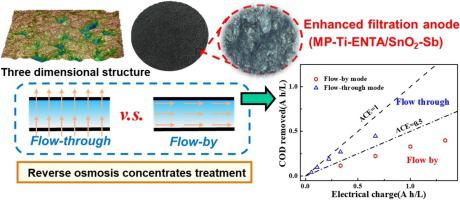Journal of Hazardous Materials ( IF 13.6 ) Pub Date : 2020-06-23 , DOI: 10.1016/j.jhazmat.2020.123295 Min Chen 1 , Xin Zhao 1 , Can Wang 1 , Shuang Pan 1 , Cong Zhang 1 , Yingcai Wang 1

|
Due to poor mass transfer performance and high energy consumption of the traditional electrochemical flow-by mode, this study developed a high-efficiency electrochemical oxidation system in flow-through mode based on three-dimensional macroporous enhanced TiO2 nanotube array/SnO2-Sb (MP-Ti-ENTA/SnO2-Sb) anode. The effects of initial pH, current density and flow rate on the COD degradation of reverse osmosis concentrates (ROCs) from reclaimed wastewater plant were investigated. Besides, the energy efficiency, biodegradability and acute biotoxicity were studied during electrochemical flow-through process. Compared with the flow-by mode, the flow-through mode based on the MP-Ti-ENTA/SnO2-Sb anode had a COD removal rate of 0.38 mg min−1 (current density: 5 mA cm-2) and an electrical efficiency per order (EE/O) of 5.3 kW h m-3. The three-dimensional fluorescence spectrum showed that the fulvic acids, humic acids and soluble microbial metabolites of ROCs could be effectively removed by the flow-through anode. In addition, the luminescence inhibition rate of the effluent was 22.4 %, indicating that the acute biotoxicity was reduced by more than 40 %. The electrochemical flow-through process of ROCs treatment required relatively low energy consumption without extra chemical agent addition, showing a broader application prospect.
中文翻译:

使用大孔Ti-ENTA / SnO2-Sb流通阳极对反渗透浓缩液进行电化学氧化:降解性能,能效和毒性评估。
由于传统电化学流通模式的传质性能差和能耗高,本研究开发了一种基于三维大孔增强TiO 2纳米管/ SnO 2 -Sb的高效流通式电化学氧化系统。(MP-Ti-ENTA / SnO 2 -Sb)阳极。研究了初始pH,电流密度和流速对再生废水厂反渗透浓缩液(ROC)COD降解的影响。此外,还研究了电化学流通过程中的能效,生物降解性和急性生物毒性。与流通模式相比,基于MP-Ti-ENTA / SnO 2 -Sb阳极的流通模式的COD去除率为0.38 mg / min-1(电流密度:5 mA cm -2)和每订单的电效率(EE / O)为5.3 kW hm -3。三维荧光光谱表明,流通阳极可有效去除ROC的富里酸,腐殖酸和可溶性微生物代谢产物。另外,流出物的发光抑制率为22.4%,表明急性生物毒性降低了40%以上。ROCs的电化学流通工艺需要相对较低的能耗,而无需添加额外的化学试剂,这显示出广阔的应用前景。



























 京公网安备 11010802027423号
京公网安备 11010802027423号